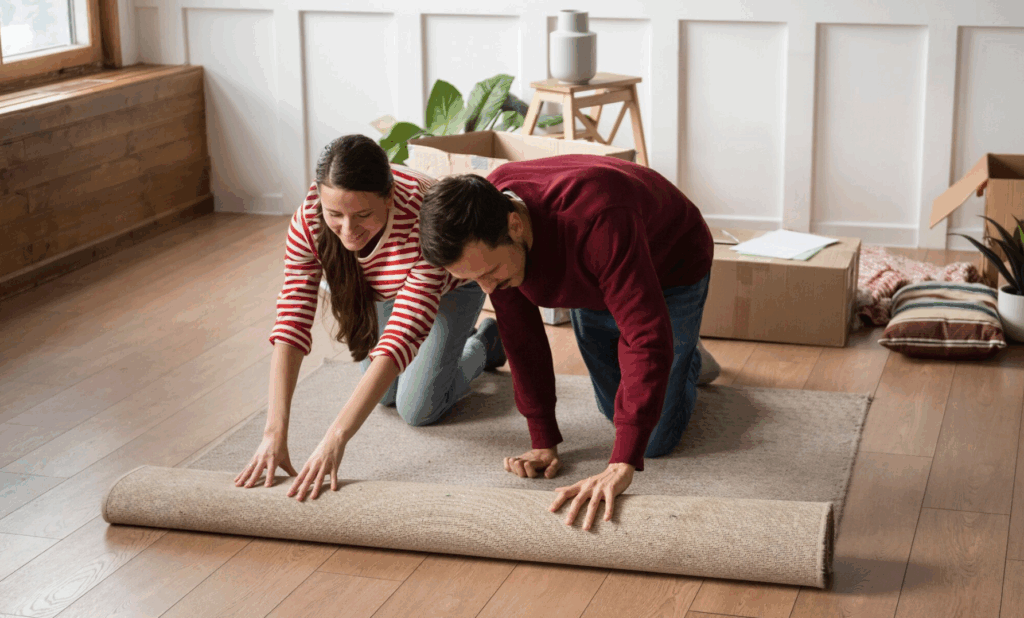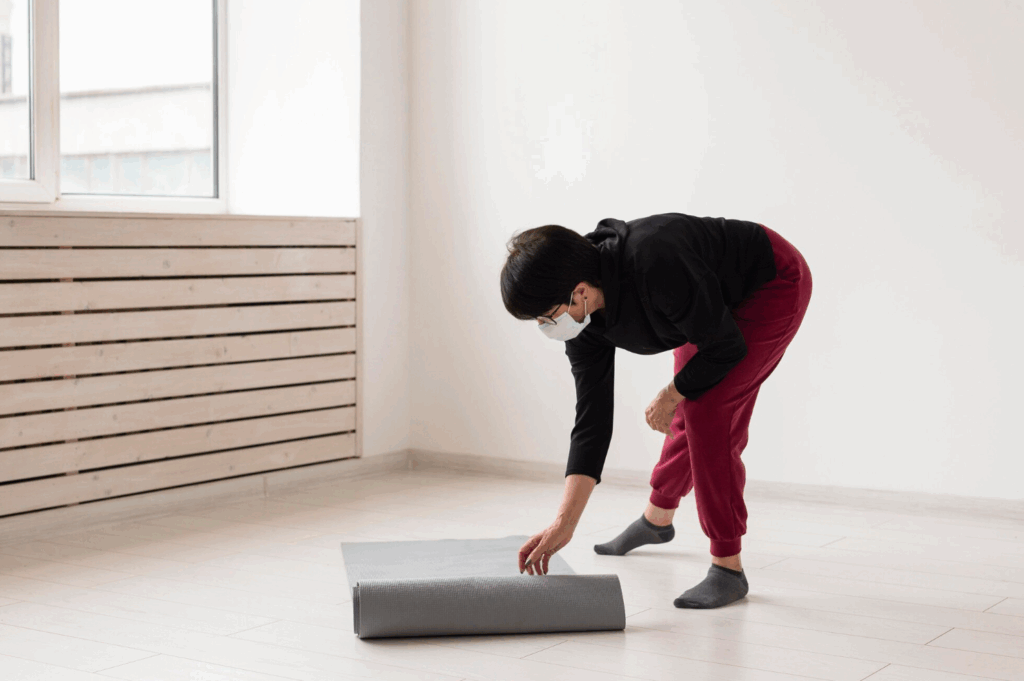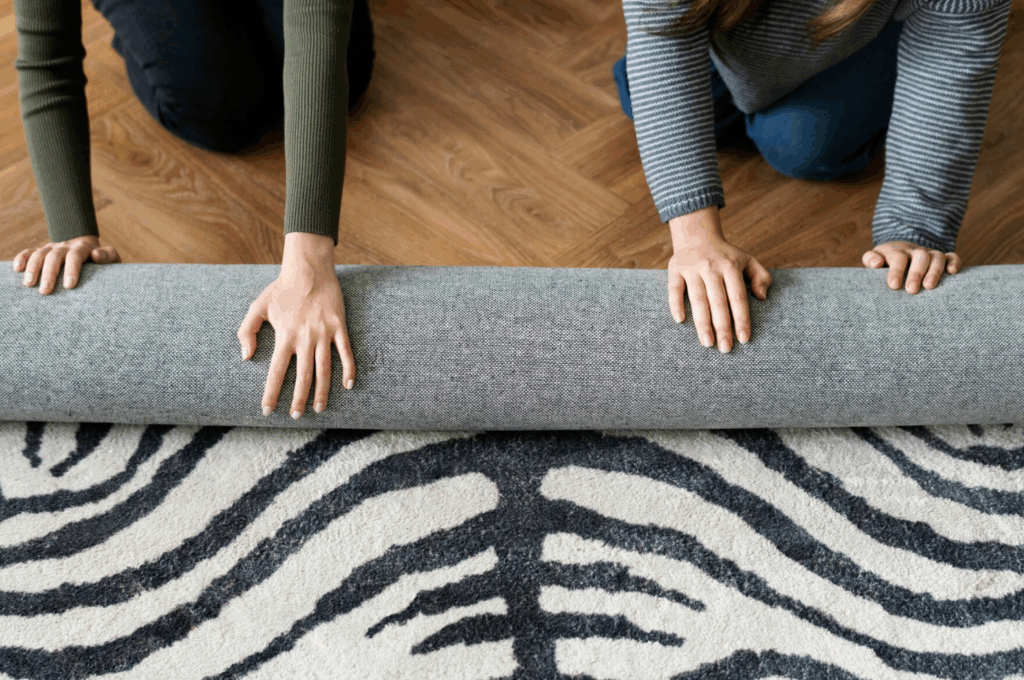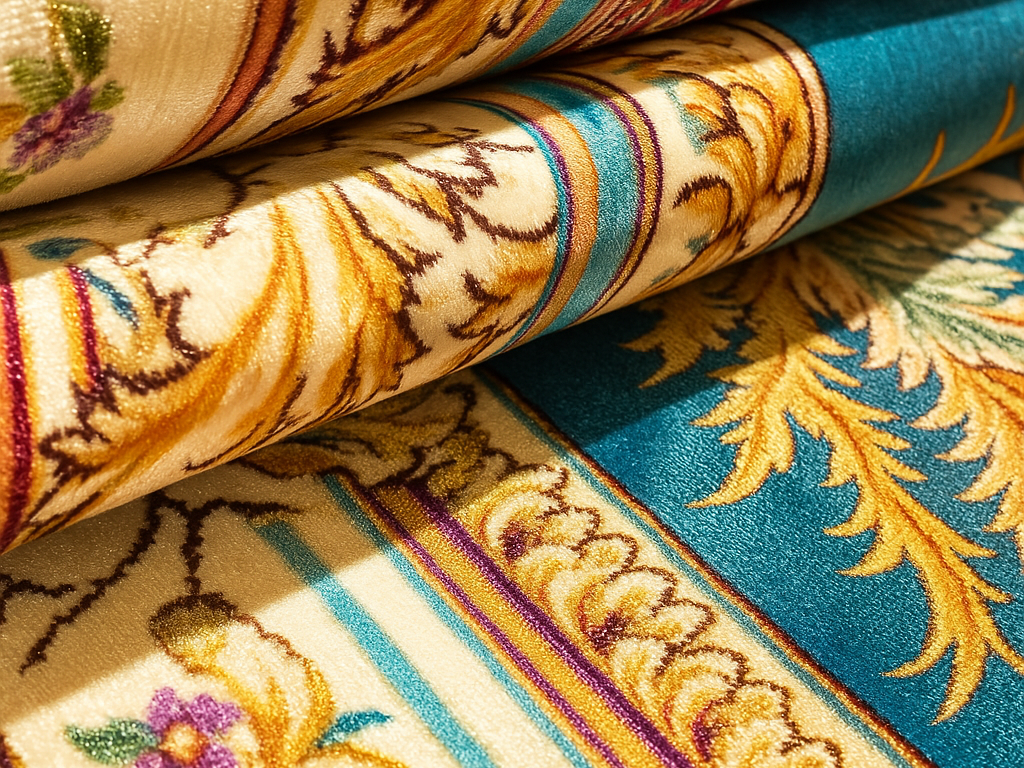Lorsque vous ramenez un beau tapis chez vous, c'est plus qu'un simple revêtement de sol : c'est une pièce d'artisanat, un élément de votre décor et un confort pour vos pieds. Mais même le plus beau des tapis n'est pas éternel. L'usure, l'âge et l'évolution des besoins finissent par le rattraper. La question clé est la suivante : à quelle fréquence devez-vous remplacer votre tapis ?

Il n'y a pas de réponse unique. La durée de vie d'un tapis dépend du matériau, de la circulation, de l'entretien et de l'environnement. Ce que nous pouvons vous offrir, ce sont des conseils éclairés (tirés des moyennes du secteur et des commentaires d'experts) et des signes clairs à surveiller, afin que vous puissiez décider quand votre tapis a vraiment fait son travail et qu'il est temps d'en acheter un nouveau.
1. Repères de durée de vie : Ce à quoi on peut s'attendre
Avant de se pencher sur les signes avant-coureurs, il convient de définir quelques attentes de base. Bien que la plupart des données concernent les moquettes, de nombreux principes s'appliquent également aux tapis. tapis d'extérieur.
- Selon certaines sources, la durée de vie moyenne des tapis d'extérieur est de 5 à 10 anssurtout en cas d'utilisation régulière.
- Pour les matériaux plus durables et les usages moins fréquents, la durée de vie s'allonge : les tapis de qualité moyenne peuvent durer de 5 à 15 ans ; certains tapis en laine haut de gamme peuvent durer beaucoup plus longtemps dans des conditions idéales.
- SynthétiqueEn revanche, les tapis moins coûteux utilisés de manière intensive peuvent ne durer que quelques années avant de se dégrader de manière visible.
- Le contexte dans lequel se trouve le tapis est important : les zones très fréquentées, les animaux domestiques, les enfants, les nettoyages fréquents, la lumière du soleil, les éclaboussures - tous ces éléments réduisent la durée de vie du tapis.
Ainsi, en tant que règle empiriqueSi votre tapis est sur 8-10 ans dans une salle occupée, ou sur 10-15 ans dans le cadre d'une utilisation plus légère, il est judicieux de l'inspecter attentivement afin de déceler les signes d'un éventuel remplacement.
2. Pourquoi un tapis ne dure pas éternellement
Même le plus beau des tapis ne peut rester parfait indéfiniment. Plusieurs facteurs interdépendants érodent progressivement son aspect, sa structure, son confort et son hygiène. Les comprendre vous permet de reconnaître le moment où votre tapis arrive à la fin de sa vie utile.

Trafic piétonnier et intensité de l'utilisation
L'un des principaux facteurs d'usure est tout simplement la fréquence à laquelle le tapis est foulé et l'énergie qu'il déploie. Les tapis en couloirs, salons, entrées et les zones similaires à fort trafic reçoivent beaucoup plus de pas, de changements de direction, de déplacements de meubles et sont plus exposés aux gravillons, aux débris et aux salissures que les tapis situés dans des espaces plus calmes.
Voici les mécanismes à l'œuvre :
- Les pas répétés écrasent le velours, aplatissent les fibres et réduisent la résilience (le ressort de la moquette/fibre qui donne au tapis un aspect moelleux). Au fil du temps, le velours reste déprimé ou "mat".
- Les chaussures, la saleté, les gravillons de l'extérieur ou même les griffes des animaux domestiques accélèrent l'abrasion de la surface - les fibres peuvent s'effilocher, se fendre ou se casser.
- MobilierLes pièces particulièrement lourdes ou les chaises à roulettes peuvent exercer une pression sur les fibres et les déformer, laissant des empreintes ou des zones plus minces avant la rupture proprement dite.
C'est pourquoi les tapis des pièces très fréquentées sont soumis à des conditions bien plus difficiles que les tapis d'une chambre d'amis rarement utilisée, par exemple. L'écart de durée de vie est réel.
Matériaux, construction et qualité
Tous les tapis ne se valent pas : les matériaux utilisés, la densité du tissage, le support, hauteur de la pileLe nombre de nœuds ou la densité du touffetage sont autant d'éléments qui déterminent la durée de vie de la forme et de la fonction du tapis.
Aspects clés :
- Type de fibre: Les fibres naturelles telles que la laine ont une plus grande résistance et une meilleure récupération que de nombreuses fibres synthétiques moins coûteuses. Par exemple, les tapis en laine peuvent durer de 10 à 20 ans, voire plus, s'ils sont bien entretenus ; certains tapis synthétiques peuvent s'user sérieusement au bout de 5 à 10 ans.
- Densité du tissage/du touffetage: Un tissage plus dense (plus de nœuds par pouce pour les tapis tissés à la main, ou un tufting plus serré pour les tapis fabriqués à la machine) signifie que les fibres se soutiennent mutuellement, résistent à l'écrasement et à l'incrustation de débris. Une ancienne référence indique que le nombre de nœuds est un important indicateur de durabilité.
- Hauteur et type de pieu: Les tapis à poils plus épais (fibres plus épaisses, boucles plus longues ou boucles coupées) peuvent sembler luxueux, mais ils s'aplatissent plus rapidement en cas de trafic intense, surtout si le support ou la base n'est pas robuste. Les tapis à poils moins épais ou à tissage plat ont tendance à mieux s'user dans les zones très fréquentées.
- Dos, finition, reliure sur chant: Le support maintient la structure de la face du tapis intacte ; s'il se détache ou se dégrade, le tapis perdra sa forme. Les franges et les bordures sont également des points d'usure courants.
En bref : un tapis bien construit peut tolérer plus d'abus ; un tapis moins cher avec des matériaux de moindre qualité montrera son âge plus tôt.
Facteurs environnementaux et géographiques
Au-delà de l'usage et du matériau, l'environnement dans lequel le tapis vit influe sur sa vitesse d'usure.
- Lumière du soleil / UV exposition: La lumière directe ou prolongée du soleil décolore les teintures, affaiblit les fibres et peut entraîner une décoloration prématurée et une rupture des fibres.
- Humidité / risque de moisissure: L'humidité affaiblit le support, peut entraîner l'apparition de moisissures sous le tapis (même si la surface semble saine) et peut provoquer des odeurs de moisi ou une dégradation de la structure.
- Saleté, poussière et allergènes: La saleté n'a pas qu'un aspect désagréable : elle agit comme du papier de verre. Les grains incrustés dans les fibres les usent à la longue. Un passage régulier de l'aspirateur est utile, mais l'absence d'aspirateur accélère la détérioration.
- Modifications de l'agencement et de l'utilisation du mobilier: Lorsque vous déplacez des meubles, ouvrez des fenêtres ou changez l'utilisation d'une pièce (jouets des enfants, activité des animaux domestiques), le tapis peut être exposé à de nouvelles contraintes pour lesquelles il n'a pas été conçu à l'origine. Par exemple, un tapis qui passe d'une chambre à coucher peu fréquentée à une salle familiale peut se dégrader plus rapidement.
- Revêtement de sol sous-jacent: Un bon tapis est très utile ; sans lui, le tapis frotte directement sur le sol dur, ce qui augmente les frottements et l'usure. (Nous reviendrons sur ce point dans la section consacrée à l'entretien).
Maintenance et entretien - ou absence de maintenance
Même le meilleur des tapis se dégrade plus rapidement s'il est négligé. Maintenance n'est pas facultative si vous voulez vivre longtemps, elle est essentielle.
Modes d'échec courants dus à des soins inadéquats :
- Accumulation de saletés et de débris : le matériau incorporé broie les fibres ; un passage régulier de l'aspirateur permet d'éviter ce phénomène.
- Déversements non traités ou mal nettoyés : les liquides pénètrent dans les fibres et le support, ce qui entraîne des taches, un affaissement des fibres ou une détérioration du support.
- Absence de rotation ou de redistribution de l'usure : Si un côté du tapis est le plus sollicité, cette partie s'usera plus rapidement, ce qui créera un aspect inégal et un déséquilibre structurel.
- Ignorer les signes de détérioration (bords effilochés, fils décousus) : les petits problèmes non traités se transforment en gros problèmes.
- L'utilisation de méthodes de nettoyage inappropriées : Par exemple, un frottement brutal, des produits chimiques inadaptés ou de la vapeur à haute température peuvent endommager les fibres au lieu de les restaurer.
D'après des études : une source a indiqué que le fait de négliger l'entretien peut réduire considérablement la durée de vie d'un tapis (par exemple, jusqu'à ~60% dans certains cas).
Évolution des besoins et inadéquation esthétique
Une raison moins technique mais réelle pour laquelle les tapis "vieillissent" est qu'ils ne sont plus adaptés à l'usage ou au décor. Même s'il est structurellement sain, un tapis peut ne plus convenir à votre style de vie :
- Si des enfants ou des animaux de compagnie viennent s'ajouter, le tapis qui a résisté à l'usage des adultes peut maintenant être vulnérable aux éclaboussures, aux griffes et aux jouets.
- Si vous déplacez le tapis dans une autre pièce (par exemple d'un salon formel à une salle de jeux), le nouveau profil de trafic peut dépasser ce pour quoi il a été conçu.
- La décoration change : les palettes de couleurs changent, les styles de meubles changent ; un tapis qui paraissait frais peut sembler fatigué ou déplacé, même s'il n'est pas encore "usé".
- Les normes de sécurité et d'hygiène évoluent : Un tapis qui accumule la poussière, les allergènes ou qui ne repose pas à plat peut devenir indésirable du point de vue du confort ou de la santé avant même d'être totalement inutilisable.
En d'autres termes, la durée de vie fonctionnelle d'un tapis ne se limite pas à l'usure physique, elle concerne également la manière dont il continue à répondre à vos besoins et à votre esthétique.
3. 10 signes évidents qu'il est temps de remplacer votre tapis
Voici dix signes pratiques indiquant que votre tapis, aussi beau soit-il, a fait son temps. Si vous en repérez plusieurs, il est temps d'envisager de le remplacer.

Tapis visible ou pile aplatie
Si les fibres ne se redressent plus, ne rebondissent plus, ou si la surface semble définitivement écrasée - même après nettoyage - la vitalité de votre tapis a disparu.
Bords effilochés, reliure lâche ou taches filandreuses
Si vous constatez que les bords se détachent, que le support transparaît ou que des zones sont dénudées en raison de la perte de fibres, il s'agit d'une usure structurelle.
Décoloration ou décoloration
La lumière du soleil, le nettoyage, le trafic et l'âge peuvent faire pâlir les couleurs de manière inégale. Si le tapis ne correspond plus à votre décor (ou n'a plus l'air frais), il est peut-être temps de le changer.
Taches ou odeurs persistantes
En cas de déversement ou d'odeur (notamment due à l'humidité ou à des accidents d'animaux) que le nettoyage ne suffit pas à éliminer, le remplacement peut être la meilleure - et la seule - solution.
Il n'est plus plat
Un bon tapis doit être plat. S'il s'enroule sur les bords, se déforme ou se déplace malgré l'utilisation d'un sous-tapis, c'est qu'il est usé ou que son support est de mauvaise qualité.
Problèmes d'allergie ou d'hygiène
Si les membres de la famille présentent des symptômes d'allergie récurrents (poussière, poils d'animaux, bactéries piégées dans les fibres) et que le nettoyage n'y change rien, votre vieux tapis peut faire partie du problème.
Odeur ou moisissure due à l'humidité ou à la détérioration du support
Même si la surface semble en bon état, les dégâts causés par l'humidité dans le passé ou la détérioration du support peuvent entraîner des odeurs de renfermé, la formation de moisissures ou des conditions dangereuses.
Le style, la taille ou l'utilisation de la pièce ont changé
Parfois, le remplacement n'est pas une question d'usure, mais de besoins. Si vous redécorez, réaménagez une pièce, ajoutez des animaux de compagnie ou des enfants, il se peut que votre tapis ne soit plus adapté à votre mode de vie. (Une source mentionne "il ne correspond plus à votre style de vie" comme un signe valable).
Le tapis a plus de 10 ans (surtout en utilisation active)
Même si vous ne constatez pas de dommages évidents, l'âge à lui seul est un signe valable. De nombreux professionnels parlent d'une dizaine d'années pour les tapis d'usage courant.
Les coûts de réparation sont de plus en plus élevés par rapport à la valeur de remplacement
Si vous avez réparé, nettoyé, renforcé plusieurs fois, et qu'à chaque fois le coût et l'effort augmentent, envisagez d'investir dans un nouveau modèle pour un confort et un aspect à long terme.
4. Quand remplacer : Un calendrier à respecter
Bien que chaque tapis soit unique, voici un guide approximatif pour les tapis à usage domestique (pas les objets de famille) afin de vous aider à planifier :
- Tapis dans les zones très fréquentées (salons, couloirs, entrées, maisons avec enfants/animaux) : Envisager un remplacement tous les 5-8 ans si vous souhaitez conserver l'aspect et la convivialité d'un produit haut de gamme.
- Tapis dans les espaces à usage modéré (chambres à coucher, chambres d'amis, peu de passage) : Vous pouvez prolonger la vie jusqu'à environ 8-12 ans.
- Tapis de luxe (laine tissée à la main ou matériaux de qualité supérieure) utilisés avec précaution : Pourrait durer 15 ans ou plusParfois des dizaines d'années, s'ils sont bien entretenus.
Si votre tapis s'approche de ces limites ou les dépasse, inspectez-le attentivement à l'aide des 10 signes ci-dessus. Chez Valhak, nous croyons qu'il faut vous aider à maximiser la durée de vie de votre tapis, mais aussi à reconnaître quand il est temps de passer à un nouveau design et à un soutien renouvelé sous les pieds.
5. Comment prolonger la durée de vie de votre tapis
Remplacer un tapis ne signifie pas que l'on renonce à l'entretenir correctement. Au contraire, un bon entretien prolonge la durée de vie, préserve l'aspect du tapis et lui confère une plus grande valeur.
- Passez régulièrement l'aspirateur : Un passage fréquent de l'aspirateur empêche la saleté de s'incruster dans les fibres. Certaines sources indiquent qu'un passage hebdomadaire est un minimum, plus souvent en cas d'utilisation intensive.
- Utiliser un tapis : Un tapis de qualité supérieure réduit les frottements, absorbe les chocs, empêche de glisser et aide le tapis à rester plat.
- Faire pivoter le tapis : Tous les 6 à 12 mois, faites pivoter le tapis de 180°, surtout si l'un des côtés est plus exposé au soleil ou au trafic. Cela permet d'uniformiser l'usure.
- Traiter immédiatement les déversements : Épongez, nettoyez délicatement, évitez de frotter trop fort. En l'absence de traitement, les taches s'incrustent et les fibres se dégradent.
- Évitez les chaussures (si possible) : En particulier dans les zones résidentielles très fréquentées. Les chaussures apportent des gravillons, des débris et de l'humidité. Certaines sources affirment que le fait de ne pas porter de chaussures sur les tapis prolonge leur durée de vie.
- Protéger de la lumière du soleil : Une exposition prolongée au soleil décolore et endommage les fibres. Pour minimiser l'effet de cette exposition, il est conseillé d'habiller les fenêtres ou d'alterner les tapis.
- Nettoyage en profondeur occasionnel : Un nettoyage professionnel une fois par an ou tous les 18 à 24 mois permet de rafraîchir l'état du tapis et d'éliminer les débris incrustés.
- L'humidité de l'esprit et les animaux de compagnie : Les accidents impliquant des animaux domestiques, l'humidité et les pièces humides réduisent considérablement la durée de vie. Si vous avez des animaux domestiques ou une pièce en sous-sol, inspectez-la plus souvent.
- Utiliser le tapis approprié dans la bonne pièce : Un modèle lourd et moelleux peut être parfait pour une chambre à coucher, mais pour l'entrée ou la salle à manger, optez pour un tissage plus serré et des matériaux durables. Adapter la qualité du tapis à son utilisation est un gage de longévité.
6. Quand la qualité compte : Matériaux et construction des tapis
Au Valhak nous croyons en la qualité - parce que de meilleurs matériaux et une meilleure construction se traduisent par une plus longue durée de vie, un meilleur confort et de meilleures performances.
Voici un aperçu des éléments à rechercher et de leur impact sur la durée de vie :
- Laine et fibres synthétiques: La laine est naturellement résistante, conserve bien ses couleurs, se répare mieux et vieillit gracieusement. D'après une étude, les tapis en laine bien entretenus peuvent durer décennies.
- Hauteur des poils et tissage : Un tapis dense, tissé serré, résiste à l'aplatissement et s'use généralement mieux qu'un tapis à poils longs dans une zone à forte circulation.
- Support et surmatelas : Le dossier du tapis doit être solide et sûr. Un bon sous-tapis sous le tapis permet d'éviter la rupture du dossier et de maintenir son intégrité.
- Finition des bords/reliure : Les tapis de qualité ont des bords bien finis ; si la reliure commence à s'effilocher, c'est un point faible.
- Entretien et garantie du fabricant : Les tapis haut de gamme sont souvent mieux construits et ont une durée de vie plus longue.
Lorsque vous choisirez votre prochain tapis, tenez compte des éléments suivants où vous le placerez, Quel est le volume de trafic ?et quel matériau correspondra à l'usage que vous en faites, ce qui vous permettra de l'utiliser le plus longtemps possible.
7. Remplacer à bon escient : ce qu'il faut prendre en compte lors de l'achat d'un nouveau tapis
Si vous avez conclu que votre tapis actuel est en fin de vie, voici comment prendre des décisions intelligentes au moment de le remplacer.
- Mesurer soigneusement l'espace et planifier la disposition des meubles. Un tapis de bonne taille sert de point d'ancrage à la pièce.
- Choisir le bon matériau en fonction de l'utilisation de la pièce. Pour les passages fréquents : peu de poils, des fibres durables (laine ou bonnes matières synthétiques). Pour un trafic plus faible : des matériaux pelucheux ou design si vous accordez plus d'importance au confort.
- Tenir compte de la couleur et du motif. Les tapis à motifs chargés peuvent cacher les taches et s'usent mieux ; les tapis plus clairs ont l'air plus frais mais se voient davantage.
- Pensez à l'entretien. En présence d'animaux domestiques ou d'enfants, choisissez un tapis résistant aux taches et facile à nettoyer.
- Support avec un tapis de haute qualité. C'est l'un des meilleurs investissements pour prolonger la durée de vie d'un tapis.
- Prévoir l'usure future. Choisissez un tapis qui coûte peut-être un peu plus cher aujourd'hui, mais qui vous donnera satisfaction pendant de nombreuses années.
8. Quand remplacer ou réparer ?
Tous les problèmes ne nécessitent pas un remplacement complet. Certaines conditions peuvent être réparées ou rafraîchies. Mais il arrive un moment où la réparation n'est plus rentable ni sûre.
La réparation peut fonctionner dans les cas suivants
- Effilochage mineur ou fils lâches sur les bords.
- Une petite tache isolée, et le tapis reste structurellement sain.
- Un léger gauchissement ou décalage - si le rembourrage sous-jacent est défaillant mais que le tapis est intact.
Le remplacement est nécessaire lorsque :
- Aplatissement généralisé, apparition d'un dos ou de grandes taches dénudées.
- Odeurs persistantes ou moisissures dues à l'humidité.
- Déchirures, brûlures ou taches irréversibles importantes.
- Le tapis ne correspond plus à votre style de vie ou à votre décor (par exemple, vous avez changé de pièce ou d'usage).
Si vous devez procéder à des réparations répétées, si les coûts d'entretien augmentent ou si le tapis ne se sent tout simplement pas bien sous les pieds, ce sont là des signes évidents qu'il est temps de le mettre au rebut.
9. Quelle est la fréquence de remplacement réelle ?
Si l'on met tout cela bout à bout, voici un guide pratique que vous pourriez utiliser pour vos tapis Valhak (dans l'hypothèse d'une utilisation domestique normale, avec un trafic modéré) :
- Entrée / Salon / Zone de grand passage: Prévoir un remplacement environ tous les 5-8 ans.
- Chambre à coucher / Zone d'utilisation modérée: Possiblement tous les 8-12 ans.
- Zone à faible trafic ou à usage occasionnel: Chaque 10-15 ans ou plussurtout s'il s'agit d'un tapis en laine de haute qualité et qu'il a été bien entretenu.
- De la laine de luxe faite à la main dans un espace peu utilisé: Pourrait durer 15-20 ans ou plusIl est donc important de les inspecter régulièrement pour détecter tout signe de détérioration.
N'oubliez pas qu'il s'agit de lignes directrices et non de règles strictes. Inspectez votre tapis tous les ans, surveillez les dix signes ci-dessus et prenez des décisions en fonction de l'état de votre tapis, et pas seulement de son âge.
10. Conclusion
Un tapis est plus qu'une simple décoration : il fait partie de la vie quotidienne de votre maison. Pourtant, même les meilleurs tapis ne durent pas éternellement. Le matériau, l'utilisation, l'entretien, l'environnement sont autant de facteurs qui influencent la durée de vie. En comprenant les repères, en vérifiant les signes d'usure et en choisissant judicieusement le moment du remplacement, vous vous assurez que votre maison reste confortable, élégante et en bon état.
11. FAQ
Q1 : Quelle est la durée de vie d'un tapis dans un salon ?
R : Pour un tapis standard dans une salle de séjour modérément utilisée, comptez environ 5-8 ans avant d'envisager sérieusement un remplacement.
Q2 : Mon tapis n'a que 6 ans mais il est décoloré et fin. Dois-je déjà le remplacer ?
R : S'il présente des traces visibles de matage, d'amincissement, de décoloration ou d'effilochage, oui. L'état de l'objet est plus important que le seul numéro d'âge.
Q3 : L'entretien des tapis fait-il vraiment une grande différence ?
R : Absolument - passer l'aspirateur, utiliser un tapis, traiter les liquides renversés, faire pivoter le tapis et éviter les dommages causés par le soleil, tout cela prolonge considérablement la durée de vie du tapis.
Q4 : Puis-je réparer mon tapis au lieu de le remplacer ?
R : Pour des dommages mineurs (bord effiloché, petite tache), vous pouvez le faire. Mais si le poil est aplati, si la structure du support est endommagée, si les taches ou les odeurs sont importantes, le remplacement est la meilleure solution à long terme.
Q5 : Si j'achète un nouveau tapis maintenant, que dois-je rechercher pour qu'il dure le plus longtemps possible ?
R : Choisissez des matériaux de haute qualité (laine ou tissage dense, par exemple), choisissez la taille et le motif qui conviennent à la pièce, investissez dans un bon sous-tapis et veillez à l'entretenir (passez l'aspirateur, faites tourner le tapis, nettoyez rapidement les éclaboussures).


